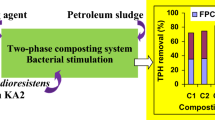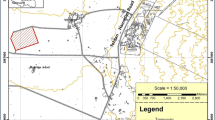Abstract
In this study, the effect of adding various bulking agents on the performance of a two-phase composting method in bioremediation of petroleum compounds from oily sludge was surveyed. The utilized system included the primary stage composting (PSC) using 6 windrow piles and the secondary stage composting (SSC) using 6 in-vessel bioreactors. Various amounts and combinations of immature compost, mature compost, and green waste were blended with oil tank bottom sludge (OTBS). Then, the mixture was added to the PSC and SSC experiments and composted for a period of 12 and 6 weeks, respectively. The results showed that the degradation percentages of total petroleum hydrocarbons in the PSC and SSC experiments were 63.56–84.50% and 57.59–88.95%, respectively. The removal efficiency reached through the two-phase system was higher than that of the single-stage process. Biodegradation was fitted to the first- and second-order kinetic with the rate constants of 0.076–0.389 day−1 and 0.006–0.176 g kg−1 day−1, respectively. The bacteria identified from the composting mixtures were Bacillus sp., Pseudomonas sp., Staphylococcus sp., and Klebsiella sp. It was concluded that the two-stage composting system, as an inexpensive and efficient method, is practically applicable for remediation of OTBS.







Similar content being viewed by others
Abbreviations
- FID:
-
Flame ionization detector
- GC:
-
Gas chromatograph
- GW:
-
Green waste
- IC:
-
Immature compost
- MC:
-
Mature compost
- OC:
-
Organic carbon
- OTBS:
-
Oil tank bottom sludge
- PSC:
-
Primary stage composting
- SSC:
-
Secondary stage composting
- TPH:
-
Total petroleum hydrocarbons
References
Koroma S, Arato A, Godio A (2015) Analyzing geophysical signature of a hydrocarbon-contaminated soil using geoelectrical surveys. Environ Earth Sci 74(4):2937–2948
Wu M, Li W, Dick WA, Ye X, Chen K, Kost D, Liming C (2017) Bioremediation of hydrocarbon degradation in a petroleum contaminated soil and microbial population and activity determination. Chemosphere 169:124–130
Chen M, Xu P, Zeng G, Yang C, Huang D, Zhang J (2015) Bioremediation of soils contaminated with polycyclic aromatic hydrocarbons, petroleum, pesticides, chlorophenols and heavy metals by composting: applications, microbes and future research needs. Biotechnol Adv 33(6):745–755
Liu C, Zhang Y, Sun S, Huang L, Yu L, Liu X, Lai R, Luo Y, Zhang Z, Zhang Z (2018) Oil recovery from tank bottom sludge using Rhamnolipids. J Petrol Sci Eng 170:14–20
Meyer DD, Beker SA, Bücker F, Peralba MdCR, Frazzon APG, Osti JF, Andreazza R, de Oliveira Camargo FA, Bento FM (2014) Bioremediation strategies for diesel and biodiesel in oxisol from southern Brazil. Int Biodeter Biodegrad 95:356–363
Yu Y, Zhang W, Chen G, Gao Y, Wang J (2014) Preparation of petroleum-degrading bacterial agent and its application in remediation of contaminated soil in Shengli oil field, China. Environ Sci Pollut Res 21(13):7929–7937
Sayara T, Sarrà M, Sánchez A (2010) Optimization and enhancement of soil bioremediation by composting using the experimental design technique. Biodegradation 21(3):345–356
Varjani SJ (2017) Microbial degradation of petroleum hydrocarbons. Bioresour Technol 223:277–286
Das AJ, Kumar R (2016) Bioremediation of petroleum contaminated soil to combat toxicity on Withania somnifera through seed priming with biosurfactant producing plant growth promoting Rhizobacteria. J Environ Manag 174:79–86
Gomez F, Sartaj M (2013) Field scale ex situ bioremediation of petroleum contaminated soil under cold climate conditions. Int Biodeterior Biodegrad 85:375–382
Nutongkaew T, Duangsuwan W, Prasertsan S, Prasertsan P (2014) Physicochemical and biochemical changes during composting of different mixing ratios of biogas sludge with palm oil mill wastes and biogas effluent. J Mater Cycles Waste Manag 16(1):131–140
Zhang Y, Guan Y, Shi Q (2015) Simulating the dynamics of polycyclic aromatic hydrocarbon (PAH) in contaminated soil through composting by COP-Compost model. Environ Sci Pollut Res 22(4):3004–3012
Vaverková M, Adamcová D, Kotrchová L, Merna J, Hermanová S (2018) Degradation of pet copolyesters under real and laboratory composting conditions. J Mater Cycles Waste Manag 20(1):414–420
Ma J, Yang Y, Dai X, Chen Y, Deng H, Zhou H, Guo S, Yan G (2016) Effects of adding bulking agent, inorganic nutrient and microbial inocula on biopile treatment for oil-field drilling waste. Chemosphere 150:17–23
Rossini-Oliva S, Mingorance M, Peña A (2017) Effect of two different composts on soil quality and on the growth of various plant species in a polymetallic acidic mine soil. Chemosphere 168:183–190
Zhang L, Sun X (2016) Influence of bulking agents on physical, chemical, and microbiological properties during the two-stage composting of green waste. Waste Manag 48:115–126
Lim MW, Von Lau E, Poh PE (2016) A comprehensive guide of remediation technologies for oil contaminated soil: present works and future directions. Mar Pollut Bullet 109(1):14–45
Liu PWG, Chang TC, Chen CH, Wang MZ, Hsu HW (2013) Effects of soil organic matter and bacterial community shift on bioremediation of diesel-contaminated soil. Int Biodeterior Biodegrad 85:661–670
Koolivand A, Naddafi K, Nabizadeh R, Saeedi R (2017) Optimization of combined in-vessel composting process and chemical oxidation for remediation of bottom sludge of crude oil storage tanks. Environ Technol 39(20):2597–2603
Koolivand A, Rajaei MS, Ghanadzadeh MJ, Saeedi R, Abtahi H, Godini K (2017) Bioremediation of storage tank bottom sludge by using a two-stage composting system: effect of mixing ratio and nutrients addition. Bioresour Technol 235:240–249
Koolivand A, Naddafi K, Nabizadeh R, Jafari A, Nasseri S, Yunesian M, Yaghmaeian K, Alimohammadi M (2014) Application of hydrogen peroxide and fenton as pre-and post-treatment steps for composting of bottom sludge from crude oil storage tanks. Petrol Sci Technol 32(13):1562–1568
Koolivand A, Godini K, Saeedi R, Abtahi H, Ghamari F (2018) Oily sludge biodegradation using a new two-phase composting method: kinetics studies and effect of aeration rate and mode. Process Biochem. https://doi.org/10.1016/j.procbio.2018.12.003
TMECC (2002) Test methods for the examination of composting and compost. USDA and US Composting Council, Washington, DC
American Public Health Association (2011) Standard methods for the examination of water and wastewater, 21st edn. APHA-AWWA-WEF, Washington, DC
Hurst CJ, Crawford RL, Garland JL, Lipson DA (2007) Manual of environmental microbiology. American Society for Microbiology Press, Washington, DC
Starr MP, Stolp H, Trüper HG, Balows A, Schlegel HG (2013) The prokaryotes: a handbook on habitats, isolation and identification of bacteria. Springer, Berlin
Texas Natural Resource Conservation Commission (2001) Total petroleum hydrocarbons, method 1005. Revision 03
Nwankwegu AS, Orji MU, Onwosi CO (2016) Studies on organic and in-organic biostimulants in bioremediation of diesel-contaminated arable soil. Chemosphere 162:148–156
Long YY, Fang Y, Zhang C, Du Y, Shentu J, Shen DS (2015) Degradation of polychlorinated biphenyls by sequential anaerobic–aerobic composting. Water Air Soil Pollut 226(3):1–12
Koolivand A, Naddafi K, Nabizadeh R, Nasseri S, Jafari AJ, Yunesian M, Yaghmaeian K (2013) Degradation of petroleum hydrocarbons from bottom sludge of crude oil storage tanks using in-vessel composting followed by oxidation with hydrogen peroxide and fenton. J Mater Cycles Waste Manag 15(3):321–327
Koolivand A, Naddafi K, Nabizadeh R, Nasseri S, Jafari AJ, Yunesian M, Yaghmaeian K, Nazmara S (2013) Biodegradation of petroleum hydrocarbons of bottom sludge from crude oil storage tanks by in-vessel composting. Toxicol Environ Chem 95(1):101–109
Wang SY, Kuo YC, Hong A, Chang YM, Kao CM (2016) Bioremediation of diesel and lubricant oil-contaminated soils using enhanced landfarming system. Chemosphere 164:558–567
Zhang Y, Zhu YG, Houot S, Qiao M, Nunan N, Garnier P (2011) Remediation of polycyclic aromatic hydrocarbon (PAH) contaminated soil through composting with fresh organic wastes. Environ Sci Pollut Res 18(9):1574–1584
He XS, Xi BD, Zhang ZY, Gao RT, Tan WB, Cui DY (2014) Insight into the evolution, redox, and metal binding properties of dissolved organic matter from municipal solid wastes using two-dimensional correlation spectroscopy. Chemosphere 117:701–707
Kulikowska D (2016) Kinetics of organic matter removal and humification progress during sewage sludge composting. Waste Manag 49:196–203
Cui E, Wu Y, Zuo Y, Chen H (2016) Effect of different biochars on antibiotic resistance genes and bacterial community during chicken manure composting. Bioresour Technol 203:11–17
Fountoulakis M, Terzakis S, Georgaki E, Drakopoulou S, Sabathianakis I, Kouzoulakis M, Manios T (2009) Oil refinery sludge and green waste simulated windrow composting. Biodegradation 20(2):177–189
Shintani M, Sugiyama K, Sakurai T, Yamada K, Kimbara K (2018) Biodegradation of A-fuel oil in soil samples with bacterial mixtures of Rhodococcus and Gordonia strains under low temperature conditions. J Biosci Bioeng. https://doi.org/10.1016/j.jbiosc.2018.07.018
Zhang Q, Zhu L, Su J, Wang J, Xie H, Wang J, Wang F (2014) Impacts of nitrogen and phosphorus on atrazine-contaminated soil remediation and detoxification by Arthrobacter sp. strain HB-5. Environ Earth Sci 71(3):1465–1471
Acknowledgements
This work was supported by Arak University of Medical Sciences (Grant no. 1091 and 731). The authors would like to express their gratitude to the financial support from Arak University of Medical Sciences.
Author information
Authors and Affiliations
Corresponding author
Additional information
Publisher's Note
Springer Nature remains neutral with regard to jurisdictional claims in published maps and institutional affiliations.
Rights and permissions
About this article
Cite this article
Koolivand, A., Abtahi, H., Godini, K. et al. Biodegradation of oil tank bottom sludge using a new two-phase composting process: kinetics and effect of different bulking agents. J Mater Cycles Waste Manag 21, 1280–1290 (2019). https://doi.org/10.1007/s10163-019-00881-x
Received:
Accepted:
Published:
Issue Date:
DOI: https://doi.org/10.1007/s10163-019-00881-x




